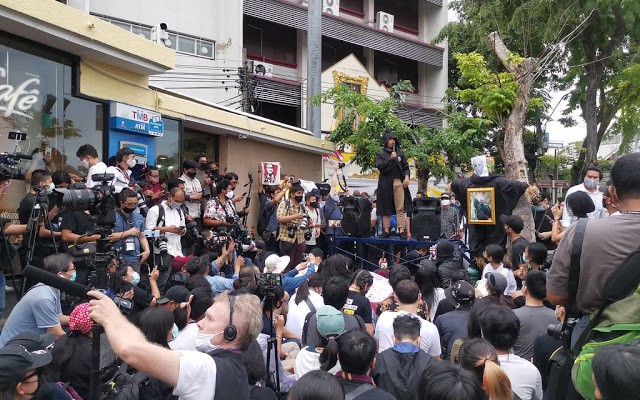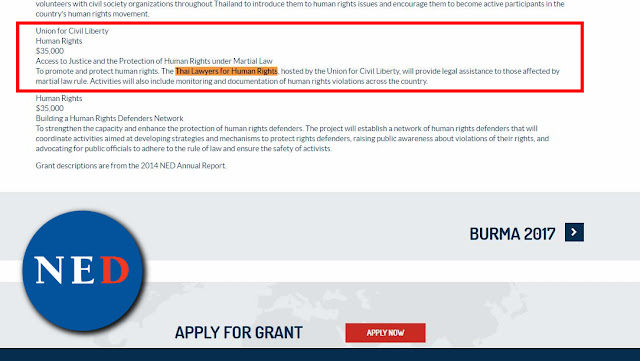It is obvious why the US would want to pursue regime change in Thailand – and failing that – what lies behind its desire to plunge the nation into disastrous chaos denying it and China any prospect of stability or prosperity.
What the Western media and US-funded fronts didn’t mention was who Anon Nampa is, his role in leading protests, who funds his activities, or why. More specifically, nothing is mentioned about the real motivations people like Anon Nampa have for targeting Thailand’s military and monarchy specifically.
Obviously the US would prefer a client regime completely dependent on Washington financially and politically – something much more preferable to strong Thai institutions like the military and monarchy which do not answer to Washington and have the resources and ability to act independently.
Despite occasionally mentioning Anon Nampa and other leaders by name, the Western media and their local partners have insisted the protests are “organic” and “leaderless” and aimed at achieving superficial and deliberately ambiguous goals like “democracy” and “human rights.”
The Protests are not “Leaderless”
Anon Nampa is a lawyer and member of Thai Lawyers for Human Rights (TLHR). The front has been funded since it was created in 2014 by the US State Department via the notorious National Endowment for Democracy (NED) long-since exposed as an arm of US-backed regime change efforts around the globe.
Bangkok Post in a 2016 article titled, “The lawyer preparing to defend herself,” would admit:
…[TLHR] receives all its funding from international donors including the EU, Germany and US-based human rights organisations and embassies of the UK and Canada.
One of TLHR’s founding members – Sirikan “June” Charoensiri – was later awarded the US State Department’s “2018 International Women of Courage Award,” presented to her by US First Lady Melania Trump.
The US embassy in Bangkok also openly praised TLHR in its own post celebrating the award, exclaiming:
The U.S. Embassy in Bangkok is proud of Sirikan “June” Charoensiri’s work as a lawyer and human rights defender, and for being recognized by the Secretary of State as an International Women of Courage award recipient.
Ms. Sirikan is a co-founder of Thai Lawyers for Human Rights (TLHR), a lawyers’ collective set up to provide pro bono legal services for human rights cases and to document human rights violations.
TLHR staff are also regularly accompanied by US and European embassy staff when hearing charges regarding their overt foreign-funded sedition.
It is clear that the US government and its European partners have invested heavily in TLHR and groups like it in Thailand.
It is also clear that TLHR and other US government-funded fronts in Thailand are leading current protests and that the Western media is deliberately attempting to nonetheless portray the protests as “leaderless,” never asking obvious questions regarding money trails and political motivations.
Why?
Secrecy an Obvious Prerequisite for Covert Regime Change
The Diplomat is an explicitly pro-Western policy journal partnered with other journals and organizations openly funded by and/or affiliated with various governments in the West including the United States government itself.
In its article, “As US-China Competition Grows, Will Covert Regime Change Make a Return?,” academics admitted that growing US-Chinese tensions provide ample motivations for Washington to pursue Cold War-style covert regime change operations against “regimes that tilt too close to China.”
The article would admit (emphasis added):
As the rivalry between the United States and China intensifies against the backdrop of a pandemic and (dis)information wars about culpability, some have wondered whether covert regime change might make a comeback. During the Cold War, the the U.S. Central Intelligence Agency (CIA), almost always at the direction of the president, quietly engineered the overthrow of numerous regimes who drifted — or were perceived to be drifting — too close to the Soviet Union. It is not hard to imagine how competition with China for the allegiances of other countries might create similar incentives.
The article notes that while the Cold War saw the height of such operations carried out by the US government, such operations have most certainly continued until present day – citing US-led regime change efforts in Syria as a specific example.
Under an entire section of the article titled, “The Appeal of Secrecy,” the authors would note (emphasis added):
The ongoing battle over the rules of international order also means that U.S. policymakers may be especially keen on hiding violations of existing laws governing intervention — laws that they helped create. Given China’s own embrace of the principles of non-intervention and non-interference, brazen violations could cede the moral high ground and result in greater support for the Chinese model. It is conceivable that these dynamics could play out in regions like Africa where the United States and China continue to compete for economic and military influence.
Finally, any consideration of using the quiet option to topple regimes that tilt too close to China must include a full accounting of the inherent risks. These include the prospect that a covert operation will become public knowledge prematurely and the possibility that it could destabilize the target state and create longstanding ill-will in the process.
Thus – by the West’s own admission – pretending obviously US-funded subversion in Thailand aimed at a Thai government that “tilts too close to China” is “organic” and “leaderless” is all part of the “covert regime change” playbook.
TLHR – brought into existence by the US embassy in Bangkok in 2014 and funded by the US government ever since – has openly led anti-government protests in Thailand alongside other similarly US-backed fronts with Anon Nampa taking on a more visible role physically leading protests in recent weeks.
Without the millions of dollars provided to Anon Nampa, TLHR, and other fronts like it by the US government their ongoing activities would be impossible and these protests would never have materialized.
Eliminating Thailand’s military and monarchy – two institutions with independent means to fund themselves and with full agency over their own decisions – and replacing them with opposition groups entirely dependent on US and European funding and political support is the surest means to rectify Thailand’s “tilt to China.”
An opposition installed into power by the US would lack any means to make its own decisions and would represent its sponsors in Washington rather than the Thai people it claims to champion for.
Obviously keeping Washington’s role in current Thai protests as quiet as possible for as long as possible is meant to protect the illusion of legitimacy the protests have been given by the Western media. It helps prevent any revelations or public outcry that “could cede the moral high ground and result in greater support for the Chinese model.”
It is neo-colonialism dressed up as a pro-democracy movement meant to end Thailand’s ability to decide for itself its own foreign policy, economic partners, and military allies. It couldn’t be any less “pro-democracy” – which is precisely why maintaining “secrecy” regarding the protest’s real sponsors and agenda is so important.
 TheAltWorld
TheAltWorld 






0 thoughts on “Why is the US Funding Protesters to Attack Thailand’s Military and Monarchy?”